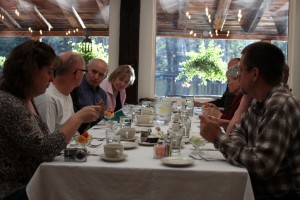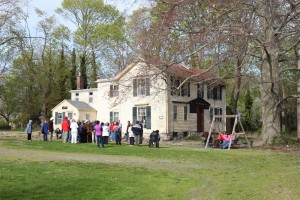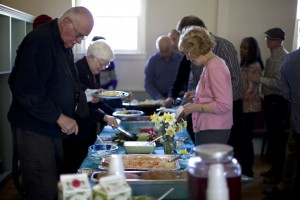I am not a morning person. I want to be, but it is not in my nature. So, when I heard that the departure time for our tour bus would be at 7:30 on a Monday morning, I got a bit nervous about my decision to take advantage of a great opportunity to travel to New England and New York with a bus full of past and current seminary faculty, staff, University administrators, and spouses. Not only would I have to be fighting extra hard to wake up even earlier than usual, but I would have to manage to keep up with the group all week. Keeping up with a bus of mostly retired or nearing-retirement aged people shouldn’t be an issue for one of the youngest people in the group, but what should be and what is are not always the same. I had struggles with my health on my mind, and I wondered if I should even be attempting this journey. I knew I would regret it if I passed up the opportunity, so I packed my bag, prayed for comfort and strength, and decided to go forward with the best attitude I could muster up.
Monday morning we loaded the bus on the Andrews University campus and departed nearly on schedule. We traveled all day and arrived at Rochester, New York, in the evening. It was a long day in the bus, but it was actually a really nice chance to sit and relax and look at the scenery as Dr. Merlin Burt, our tour guide, began to share some interesting information. Before too long, the day had passed and we were at our hotel. After supper I decided to check out a walking trail that ran along the side of the hotel grounds as I thought it would be nice to get some exercise after sitting on the bus most of the day.
Tuesday began our sight-seeing activities. In the morning we visited the Mount Hope Cemetery in Rochester, New York, to see the gravesites of Nathaniel and Anna White, as well as some from the Andrews family. While we were there I found out that there are also some gravesites of notable people from U.S. history, but after Dr. Burt told us about the Andrews family, we had to leave to keep on schedule, so we didn’t have time to walk to the other section of the cemetery. We drove through Rochester as Dr. Burt pointed out where important events had taken place. In the evening we arrived at the Old Mill Restaurant where we had supper. The restaurant is actually an old mill and the grounds are beautiful with the mill pond outside the dining room window with ducks swimming around very peacefully. We were served a delicious dinner complete with the famous corn fritters I’d been hearing so much about. During the meal Ann Gibson, retired Dean of the School of Business, shared some stories of growing up in the area and the special occasions when she would get to eat at the Old Mill. The golden evening sun set as we were finishing our dessert and I was thankful to be there, thoroughly enjoying myself.
Wednesday morning we visited Old Sturbridge Village to experience a little bit of what it would have been like to live during the time of the Adventist pioneers. The village is a living museum that is set up as a town in rural New England between 1790 and 1840. I didn’t have enough time to see everything; I wished I did, but I enjoyed looking through as much as I could. I listened to the cobbler tell about how they made shoes at their shop. There were no left and right shoes, just one shoe shape that was sold in pairs and that would develop into left and right shoes as they were worn. Of course, I checked out the printing press and I stopped by the bank and the cooper’s place and the tin shop. But my favorite part of the village was the store. They had a bit of everything and the goods were both from nearby manufacturers as well as from all around the world. It was remarkable to me how even though they only had one fairly small shop they had access to basically all the goods they needed. It also made me think about how we are bombarded with stuff in modern society. We seem to have access to an endless supply of goods, but how many of them do we even have time to use?
In the afternoon we went to Fairhaven where we listened to the Sabbath story at the site of the Fairhaven Bridge. Later in the day, we visited the childhood home of Joseph Bates. We had a lovely time visiting with Delores and Jim Wright, the couple who manages the home, and listening to stories about Joseph Bates, as well as learning about the restoration process that is going on at the home.
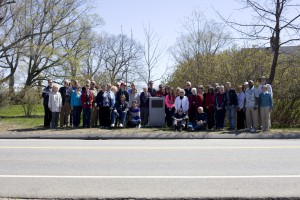
Group photograph of participants with the historical marker designating Gorham, Maine as the birthplace of Ellen White.
Thursday, we went to Gorham, Maine, where we visited the North Street Cemetery where Ellen’s sister, Elizabeth, and her family are buried. Dr. Burt told us about Ellen’s relationship with her sister and how she longed for her sister to know Jesus as she did. He read to us from a particularly emotional letter to Elizabeth where Ellen pleaded with her to give her heart to Jesus. It was difficult for me to imagine why Elizabeth would have resisted. After the cemetery, we saw the valley where the Harmon home stood at the time of Ellen’s birth. We drove past the home the Harmon family lived in between 1846 and 1853. James and Ellen White lived there with her parents for more than a year after their marriage. We took a group photo at the Gorham historic marker which notes the area as the place of Ellen White’s birth. Being there in the places where the stories of the early days of the church took place made it a bit easier to imagine as I listened to Dr. Burt tell us important bits of our church heritage.
I have to mention our lunch on Thursday. We were treated to a wonderful lunch at the Northern New England Conference Office. We couldn’t have asked for better hosts! We had a homemade meal, complete with a variety of pies to choose from! I am sure every one of us left more than satisfied. After we left the conference office we enjoyed a relaxing visit to the historic Portland Head Lighthouse. It was exciting to see the most famous lighthouse in the country, and to have time to explore the grounds and take some pictures. The weather was beautiful, and it was a really refreshing experience; probably one of the only times we were off the bus and just totally relaxing.

Many participants had their pictures taken with the Portland Head Light, at Fort Williams Park, in Cape Elizabeth, Maine.
After visiting the lighthouse, we drove through Old Portland and saw the Site of the Harmon home when Ellen was a girl. We drove through the area where Ellen’s accident took place. Even though the buildings have changed and the area is totally different now, I found it much easier to imagine the event as Dr. Burt explained where the Brackett Street School had stood and where Ellen’s home had been and how the area probably would have looked at the time. We also saw the Chestnut Street Methodist Church where the Harmon family attended during the early 1840’s. Being a person who likes to visit new places simply to experience the adventure, I had not expected to be so impressed by the historical sites on this trip. I expected to enjoy the experience and to gain a blessing and even to learn some things, but nothing more. However, as we visited different sites and talked about what had happened there, I began to appreciate my personal connection to these events and places and to ancestors in faith.
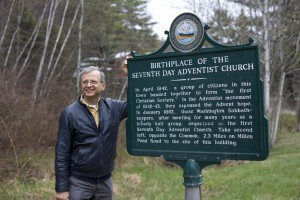
Jiří Moskala stands next to the historical marker indicating Washington, New Hampshire as the birthplace of the Seventh-day Adventsist Church.
We spent Friday morning at the Washington, New Hampshire church; the earliest Sabbath-keeping Millerite church, which is still a Seventh-day Adventist church. It was a chilly day and we were thankful for the heat from the stove as we listened to stories of the revival among the Millerite youth, William and his twenty-two children, as well as the spiritual journey of Worcester Ball. After the talk and some singing and a group prayer, we had time to stroll around the cemetery or walk the Sabbath Trail. It was too chilly for me, however, and I stayed in the church where it was warmer! Later, after a good Adventist lunch of haystacks, we visited West Wilton, New Hampshire, and the childhood home of Uriah and Annie Smith. The couple who now own the Smith Home are very lovely people and wonderful hosts. They opened their home to us and made us feel very welcome. When we finished visiting with them, we hurried on to Keene, New Hampshire, where we ate supper at Country Life Restaurant. There we enjoyed a wonderful, healthy meal, specially prepared for us by Peggy and Peter Shauffler, the owners. By the time we finished it was getting near sunset, so we had a short worship on the bus to usher in the Sabbath and sang some songs.
We spent most of Sabbath at the William Miller farm in Low Hampton, New York, where we had church in the Miller Chapel. We sang songs from the tour songbook and Jim Nix preached a short sermon. We listened to the Miller story. We sat out in the sunlight on ascension rock and heard about the disappointment of the believers when Christ didn’t return as they had thought He would. We walked through the Miller home. Then, after a picnic lunch, we went back to the chapel for a short afternoon meeting where we heard about the sacrifices of the early Adventist pioneers. We ended the meeting with foot washing and communion. After we were finished at the Miller farm we went a short way to the cemetery where William Miller is buried. Finally, we went to our hotel and had worship to close the Sabbath.
I was amused by the hotel employee who was helping us as we got in on Saturday night. We asked her if it would be okay to gather together in the breakfast area off of the lobby and have a short meeting with some singing. She seemed slightly confused, but said it should be fine. We explained that the meeting would be of a religious nature and we didn’t want to offend anyone or cause the hotel any problems. She still seemed slightly confused, but said she was fine with it as long as she could video us to use on their Facebook page!
Sunday we went to the Roosevelt Church and Roosevelt Cemetery in Roosevelt, New York. We were warmly greeted by a few of the church members and we enjoyed sitting in the original pews, listening to more stories told by Dr. Burt as he stood at the original pulpit. After visiting over lunch, we listened to a few more stories in the cemetery and then went on to the Hiram Edson Farm in Clifton Springs, New York, where we held our own little barn meeting in the theological birthplace of the Seventh-day Adventist Church. There are still open fields surrounding the farm, though I didn’t notice whether there was corn growing at the time we were there. With the fields surrounding us, it wasn’t difficult to imagine Hiram Edson walking through the fields when he experienced his insight that not only encouraged his faith, but that ultimately gave us our sanctuary doctrine.
With that, our touring had come to an end. Sunday evening we enjoyed a nice supper and some of us went into town to visit the local Lilac Festival that was taking place. I enjoyed walking around in the 100 year-old lilac garden and taking pictures with Katy Wolfer, the tour organizer. Finally, we rested our tired heads for one last night in a hotel. After another long day in the bus we would be home the following evening.
It had been a really good week and I was very thankful I had decided to go. I had done my best to put my worries on Jesus and just trust Him, and I found that I felt better that week than I had in a long time. Despite working at the Center for Adventist Research and being surrounded with information about our Adventist heritage on a daily basis, I found that being there in the places where the stories took place, listening to the stories being told with such passion, it became so much more meaningful to me. I became very aware of how those events of the past connect to me and to all of us, not only now, but as long as we are living in the Blessed Hope.
To see more pictures visit facebook.com/netour/.
Wendy Halder, Periodicals Associate / Wendy enjoys going on any adventures, whether they be as close as Chicago or as far away as Russia.
From Participants …
by Katy Wolfer
May 5-12, 2014
We asked for feedback from the Seminary faculty and staff, and other invited participants of the Adventist History Tour. The following are quotes taken from their comments.
“We all have our own Adventist History story.” – David Sedlacek
“As I reflect over the week, the part that impacted me the most was at the grave of Lizzie. … Could I write a letter like that? To a person as close to me as Lizzie was to her?” – Russell Burrill
“I particularly enjoyed the Miller farm and Washington, NH church. Although I have heard the stories before, I have never heard the stories told with such passion. I think of Jim Nix and it just poured out of him.” – Roger Dudley
“I always thought that if God had a special task for you that God would take away the hurdles. The pioneers had such suffering. I think particularly of J. N. Andrews’ story we heard at the cemetery.” – Peggy Dudley
“You teach that course, Development of Seventh-day Adventist Theology; I have a sudden interest in on sitting in that class.” – Peter Swanson
“This week has me proud to be a colleague in the Church History department. One of the problems of teaching early church history is showing what went wrong. And now we as Adventists are in danger of teaching things just because they are tradition. Adventists have a history of looking at a teaching and getting it from scripture and confirming it by prophetic gift. Our strength as a people comes from our connection with Jesus Christ through scriptures.” – John Reeve
“What would it look like if we were as excited about the soon coming of Jesus as the pioneers were? What would my teaching look like? What would the seminary look like? To let Jesus lead us to where he wants us to step next?” – Teresa Reeve
“I appreciated learning about the pioneers and their humanness.” – Sallie Alger
“I am amazed that these people were so fired up. Then I got to thinking that we may not be so far away from Jesus’ coming as we might think.” – Cynthia Burrill
“I have appreciated the big picture focus, where you are able to say at the end that this connects to this. I had never heard expressly communicated the focus of Ellen White’s love for Jesus. – Donna Habenicht


